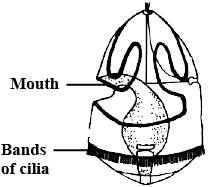Answer
425.4k+ views
Hint: The Hemichordata Balanoglossus sp. is known as tongue worm. Tornaria larva is of some hemichordata species.
Complete answer: Balanoglossus sp. is a Hemichordate species. It belongs to the class Enteropneusta of the phylum Hemichordata.
Being a Hemichordate, it links between non-chordata and chordate animals. Because of this reason it has an important evolutionary significance. It is a burrowing animal and exclusively marine. These ocean-dwellers are also called acorn worms. In Hemichordates, their body is divisible into proboscis, collar, and trunk- this is the basic unique characteristic feature. Head and tail are absent in Balanoglossus.
The proboscis of this animal protrudes outside and appears like a tongue. This is the reason they are called ‘tongue worms’. The young swimming juveniles produced by them are called Tornaria larva. It is a planktonic larva. Tornaria appears very similar to the bipinnaria larvae of some Echinoderms (Starfishes). They have convoluted ciliary bands running around the body.
Tornaria larva was first described by Muller, in 1850. It possesses an oval and transparent body. It measures up to 3 mm in size. At the anterior end of its body, a tuft of cilia and a pair of eye spots are present. Its digestive system is differentiated into oesophagus, stomach and intestine.

So, the correct answer is B. Tornaria.
Note: The group of parasitic crustaceans called ‘Pentastomida’ are also commonly called tongue worms. They basically belong to the subphylum Crustacea. It is assumed that they are the connecting links between annelids and arthropods- Though it is a debatable concept.
Complete answer: Balanoglossus sp. is a Hemichordate species. It belongs to the class Enteropneusta of the phylum Hemichordata.
Being a Hemichordate, it links between non-chordata and chordate animals. Because of this reason it has an important evolutionary significance. It is a burrowing animal and exclusively marine. These ocean-dwellers are also called acorn worms. In Hemichordates, their body is divisible into proboscis, collar, and trunk- this is the basic unique characteristic feature. Head and tail are absent in Balanoglossus.
The proboscis of this animal protrudes outside and appears like a tongue. This is the reason they are called ‘tongue worms’. The young swimming juveniles produced by them are called Tornaria larva. It is a planktonic larva. Tornaria appears very similar to the bipinnaria larvae of some Echinoderms (Starfishes). They have convoluted ciliary bands running around the body.
Tornaria larva was first described by Muller, in 1850. It possesses an oval and transparent body. It measures up to 3 mm in size. At the anterior end of its body, a tuft of cilia and a pair of eye spots are present. Its digestive system is differentiated into oesophagus, stomach and intestine.

So, the correct answer is B. Tornaria.
Note: The group of parasitic crustaceans called ‘Pentastomida’ are also commonly called tongue worms. They basically belong to the subphylum Crustacea. It is assumed that they are the connecting links between annelids and arthropods- Though it is a debatable concept.
Recently Updated Pages
How many sigma and pi bonds are present in HCequiv class 11 chemistry CBSE

Why Are Noble Gases NonReactive class 11 chemistry CBSE

Let X and Y be the sets of all positive divisors of class 11 maths CBSE

Let x and y be 2 real numbers which satisfy the equations class 11 maths CBSE

Let x 4log 2sqrt 9k 1 + 7 and y dfrac132log 2sqrt5 class 11 maths CBSE

Let x22ax+b20 and x22bx+a20 be two equations Then the class 11 maths CBSE

Trending doubts
Fill the blanks with the suitable prepositions 1 The class 9 english CBSE

At which age domestication of animals started A Neolithic class 11 social science CBSE

Which are the Top 10 Largest Countries of the World?

Give 10 examples for herbs , shrubs , climbers , creepers

Difference between Prokaryotic cell and Eukaryotic class 11 biology CBSE

Difference Between Plant Cell and Animal Cell

Write a letter to the principal requesting him to grant class 10 english CBSE

Change the following sentences into negative and interrogative class 10 english CBSE

Fill in the blanks A 1 lakh ten thousand B 1 million class 9 maths CBSE



